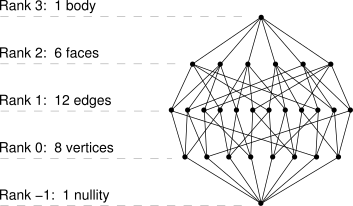To kick off, a more formal definition: An abstract polytope is a partially-ordered set (poset) of members or elements. The elements are ranked according to their dimension, with an incidence relation existing between pairs of elements in adjacent ranks. The partial-ordering must meet three conditions, which Norman Johnson has described as monal, dyadic and properly-connected. This basically means just two elements of any given dimension meeting on (incident with) the same element of one dimension lower, and no cheating with duplicate elements, structures, etc.
Such an abstract structure may be described in a Hasse diagram. In particular, the dyadic requirement leads to a characteristic embedding of diamond shapes in the diagram, leading to its common name as the diamond condition. Here is the Hasse diagram of the cube:

Note the need for a maximal (body) and a minimal (nullity) element for the set theory to work properly.
Dualising an abstract polytope is stunningly simple; you turn the Hasse diagram upside down (more correctly, you reverse the order of ranking). That is it, it is now the abstract octahedron!
Early versions of the theory treated everything as sets of vertex points; an edge was the set of its two ends, for example, while the nullity was the empty set. However dualising is a pain because the dual has different vertices from the original and the sets of vertices all have to be relabelled. In fact, abstract algebra becomes most tractable and elegant when you treat each element as an atomic object in its own right.
It is sometimes argued that the nullity must be the empty set, because every set contains the empty set. But this commits the elementary blunder of confusing membership with containment. Any set contains all possible combinations of its elements, but not all those combinations need be members of it; the empty set is always contained, but it is not necessarily a member. And the Hasse diagram shows only the members. So modern approaches treat the nullity as just like any other member - I think of it as the null polytope or nullon.
Things get really interesting in four dimensions and above, where abstract theory becomes more general than traditional topology. For example the 11-cell and 57-cell regular polychora are not properly constructed topological manifolds, but they are valid abstract polytopes.
I expand on the basics at https://www.steelpillow.com/polyhedra/abstract/abstract.html

